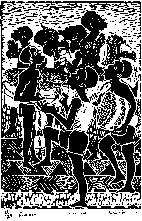The Valley Tonga
- Details
- Created: Tuesday, 27 December 2005 18:33
The best known fact about the Tonga is that they were forcibly removed from the banks of the Zambezi River forty years ago to make way for the building of Kariba. Once deported from their habitat, they were abandoned.
In recent years, they have gained some outside attention largely through the beauty of their material culture (in particular their basket work and their goblet drums) which have become popular with the tourist trade.
 Before the dam, the Tonga were able to grow two crops a year. Their winter gardens were made possible by the flooding of the Zambezi river which brought rich alluvial soils every year. The ground they now live on since their displacement is desperately poor and barely sustains one yearly crop of drought-resistant sorghum. Furthermore, they are plagued by damage done to their crops from wildlife which they are now forbidden to hunt.
Before the dam, the Tonga were able to grow two crops a year. Their winter gardens were made possible by the flooding of the Zambezi river which brought rich alluvial soils every year. The ground they now live on since their displacement is desperately poor and barely sustains one yearly crop of drought-resistant sorghum. Furthermore, they are plagued by damage done to their crops from wildlife which they are now forbidden to hunt.
The Tonga are a marginalised people who do not share in the luxuries of modern life in Zimbabwe. Until recently, they viewed outsiders with suspicion and their remote position has not encouraged investment in the area. Even the advantages of electricity and tourism which Kariba dam brought to the cities, have bypassed the Tonga almost completely.
Although the Tonga lost so much with the coming of Kariba, they managed to maintain their cultural identity. The KUNZWANA Tonga Cultural Project was set up to find ways in which the Valley Tonga people might exploit this distinct and vibrant heritage to their own advantage.
Nyaminyami is the Valley Tonga river spirit. His promise is that, one day, the Tonga will return to their original homes on the banks of the Zambezi.
N Y A M I N Y A M I
Celebrating Valley Tonga Culture

"Budima" Linocut Patrick Mweemba ' 97
1957 - 1997
Forty Years of Survival
The Valley Tonga - On the Edge of Development
A KUNZWANA Trust & Arge-Zimbabwe Project
Background:
For centuries, the Gwembe Valley Tonga lived along the north and south banks of the Zambezi river. In 1958 they were forced to move out of their habitat by the rising waters of Lake Kariba due to the damming of the Zambezi - a hydro-electric project of the then Federation of Rhodesia and Nyasaland. The resettlement was followed by a physical separation by the new lake, later reinforced by the incorporation of the Tonga people into two different nations, Zambia and Zimbabwe, where the Tonga are the third-largest ethnic and language group after the Shona and Ndebele and the most marginalised in the country. They are largely cut off from the benefits which automatically accrue to other Zimbabweans, especially those in urban areas. The building of Kariba dam brought electricity to the rest of Zimbabwe and quite some revenue and commercial benefits from tourism. These benefits have all but completely bypassed the Tonga.
When forcibly removed to make way for the building of Kariba, the Tonga lost everything including the fixed assets of their material culture such as their shrines. Their cultural styles were automatically transported with them because they filled no extra space and could not anyway have been separated from the bodies being moved. The Tonga maintained their identity by organising around what remained of their culture and, because the culture was dynamic, it helped them face and adapt to the massive challenges that their new environment presented them. Put very simply, the Tonga invested heavily in their culture and this meant they survived.
At the same time they maintain a strong individuality within community which is perfectly expressed in their unique style of music as Andrew Tracey (International Library of African Music / SA) has stated at a recent visit: “Of course the whole sound of the music of Ngoma Buntibe is highly involving, complex and compelling and the fact that each person’s part is completely different from every other person is a real challenge, fully demonstrating the universal African musical principle of independence within inter-dependence, or of individuality within community, however you like to put it”.
It is this rich cultural heritage of the Tonga that drew the attention of Kunzwana Trust, a Harare-based NGO that is involved in promoting musical traditions of Zimbabwe, to facilitate the development of Internet access in Binga. In partnership with AZFA, Kunzwana Trust is carrying out a cultural exchange programme between the Tonga community artists and Austrian artists since 1995.
As a cultural organisation, Kunzwana is committed to the promotion of Tonga culture. Through the development of web-based skills and the strengthening of the Twiilambane sound studio which has begun a project of recording, digitizing and thus preserving the musical culture of the Tonga people, the Tonga people will continue to be able to document their own culture. A cataloguing system is in the process of being set up with the assistance of the International Library of African Music. The sound studio is also responsible for the development of a kankolimba project, sponsored by Binga Museum, which is in the advanced stages of developing a set of marimba-style instruments which will facilitate the transcription of the nyele horns of the ngoma buntibe. Use of the studio is frequent and, with the inclusion of a small mixer, the creation of a sound-proofed room at Binga High school, it is now possible to produce high-quality recordings. The documentation i.e. of the repertoire of a kantimbwa player (a bow instrument now nearing extinction) is an important step towards ensuring that the music and culture of the Tonga people remains alive.
The Tonga.Online project intends to expose the general public to the distinctive qualities of Tonga culture, in particular its wonderful and often strange-sounding music.
A New Valley
by Jameson Muleya, Binga
When I look northwest of the school
What can I see?
Yes, the deep division between
Zambia and Zimbabwe,
Glittering though it appears.
Where did it come from?
What was there before?
Was it the baTonga people?
Yes, the baTonga
Now divided.
Yes, hardy people of the Kasasambezi Valley.
In a cool and remarkable place,
There they lived.
Not a wandering people, they lived.
Famineless, they lived.
Warless, they lived.
With wisdom, welcoming to friends.
But what happened in the 1950s?
By contrast a disgrace.
Against it, the generous baTonga spirits were really helpless.
Helpless, they were driven
Away, they were driven
Unthoughtfully, they were settled
For the good only of selfish grants.
Where is your wealth my dear fellows?
In rocky places it was lost.
Where are the rains, now that they matter?
In the valley, crops were grown even when no rain fell.
But now you must cry for the rain that does not come.
Mawala, did you go with all your Spiritual Powers?
Oh! Heavenly Father, why were you during that time
Not defending such innocent souls?
Siadongo; Sikulibbamba; Kanundu; Moonga;
Siampongo; Chikwenga; SiMwaaba;
Mawala, why did you desert us at such a time?
Why did you allow foreigners to chase you from your favourite valley?
Oh! My wise ancestors,
Rest in peace and watch your toiling children,
They are building a new valley for a home.
From: Lwaano Lwanyika, Tonga Book of the Earth by Pamela Reynolds & Colleen Crawford Cousins, Baobab Books, Harare, 1991.
